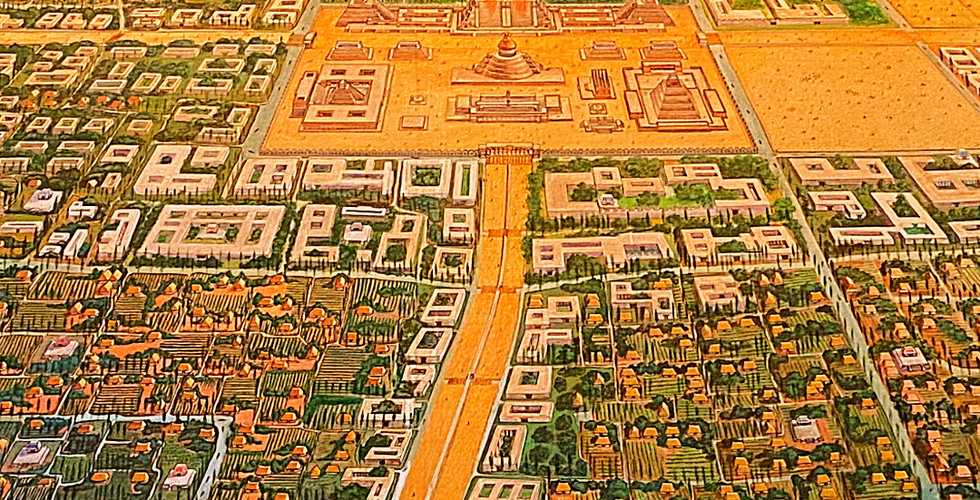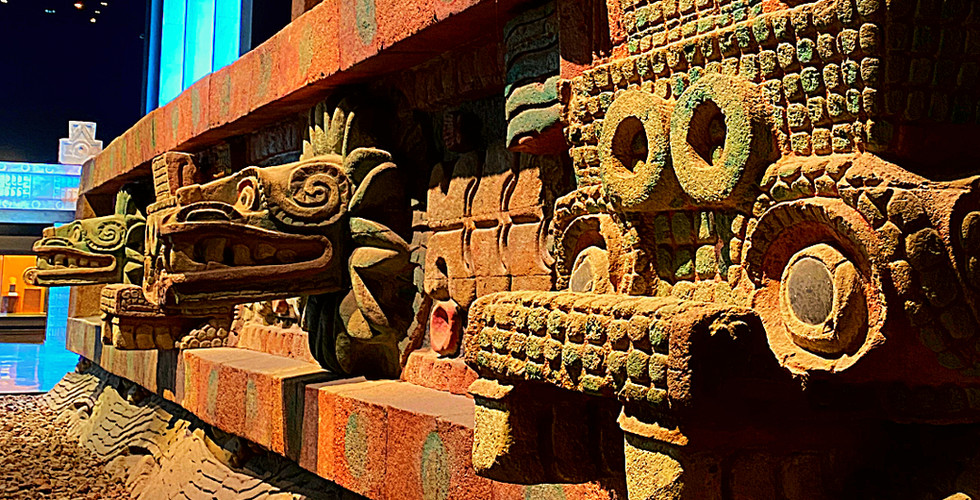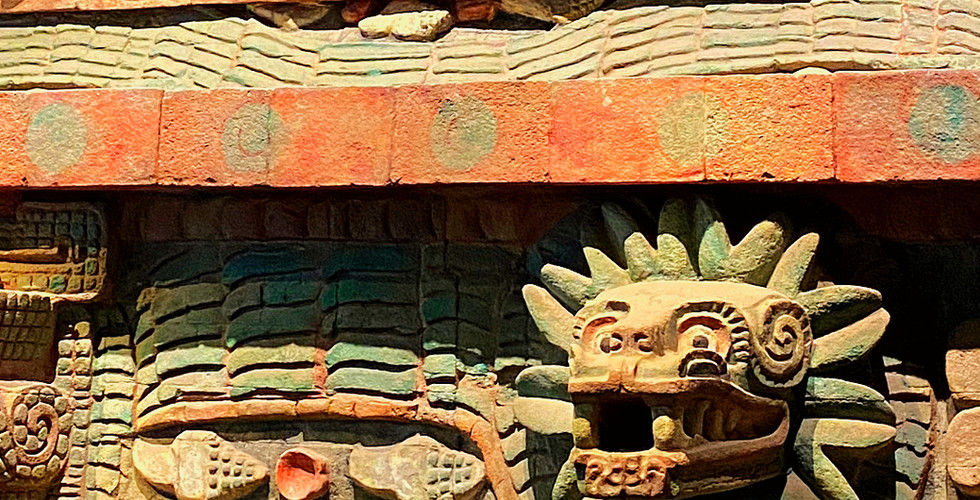Mexico City Pyramids: Unearthing Ancient Wonders in the City of Gods By Backpacker’s Blueprint
- Feb 1
- 12 min read
Updated: Feb 12
In the heart of Mexico City and its outskirts lie some of the world’s most extraordinary architectural wonders; the pyramids. These awe-inspiring structures are more than relics of ancient civilisations. They’re the blueprints of human ambition, spiritual devotion, and architectural mastery.
From the towering grandeur of Teotihuacan to the symbolic remnants of Templo Mayor and the volcanic mystery of Cuicuilco, each site offers a glimpse into a world where architecture wasn’t just about structures; it was about storytelling. Let’s dive deeper into the design, construction, and cultural significance of these pyramids.
CONTENT LINKS
Mexico City Exploration Map
Mexico City Pyramids on the Map
The green items on the map are the Backpacker's Blueprint curated choice of top architecture sites, find them at 10 best pieces of architecture in Mexico City and consider adding them to your list. Now to to Mexico pyramids.
No.1. Teotihuacan: The Pyramid City

Estimated Dates of Construction
Teotihuacan was established around 100 BCE and flourished between 200-550 CE. The Pyramid of the Sun, its largest structure, was completed by 200 CE, while the Pyramid of the Moon was finished around 250 CE. Archaeologists believe the city's decline began around 600 CE, but its influence on Mesoamerican architecture lasted centuries.
Architectural Design & Construction
The pyramids are built using sun-dried adobe bricks, volcanic stone, and lime plaster. The Pyramid of the Sun, rising 65 metres (213 feet), rests on a square base measuring 220 metres (720 feet) on each side. Its alignment with the setting sun during the summer solstice suggests a strong connection to celestial events.
The Pyramid of the Moon, though smaller at 43 metres (141 feet), is situated on higher ground, creating a perfect visual balance when viewed from the Avenue of the Dead. Its design mirrors the contours of Cerro Gordo, a nearby mountain, symbolising the sacred connection between the earth and the cosmos.
The Avenue of the Dead
This grand, 2.5-kilometre avenue served as the city’s ceremonial core, connecting the pyramids and surrounding plazas. The avenue’s width and alignment underscore the planners’ mastery of urban scale and geometry.
Purpose and Use
These pyramids weren’t tombs but platforms for rituals. The Pyramid of the Sun likely served as a site for sacrificial ceremonies to honour the sun, while the Pyramid of the Moon was dedicated to the Great Goddess of Teotihuacan, associated with fertility and water. Excavations have revealed remains of human and animal sacrifices at the summit platforms, reinforcing their ritualistic significance.
2. Templo Mayor: The Sacred Heart of Tenochtitlan
Dates and Phases of Construction
The Templo Mayor, constructed around 1325 CE when Tenochtitlan was founded, was expanded over six phases until its destruction in 1521 CE by Spanish conquistadors. Each phase added height and detail, reflecting the Aztecs’ growing power and wealth. The archaeological site is a stones throw away (excuse the pun) from the site of the Parroquia de la Asunción Sagrario Metropolitano, which uses stone taken directly from the Aztec site.
You can find out more on this on my blog on a day trip to 3 architectural sites to explore in Mexico City. For me, the archaeology site is not the best place to explore the Templo Mayor. Whilst that sounds ridiculous I know, in this humble architect and history lovers opinion, the best place to get a deep insight into Tenochtitlan and the Templo Mayor is at Museo Nacional de Antropología. I took the images above in the museum, the reconstruction of the temples are fantastic.
Another thing to take into consideration is that if like me you tend to do a walking tour through a Guru free walking tour or a pay before you play paid guide (links are recommended tours), as one of the first things you do when you get to a new city, then your guide will talk about the archaeological site and its relationship in context to Mexico City.
I am not trying to put you off paying to go and walk amongst the ruins please do, but, I personally feel you are better doing a walking tour, hitting the museum, and doing a day trip to Teotihuacan. That said, the museum attached to Teotihuacan is home to more than 3,000 artifacts of Mexica culture. With exhibits on offerings, burials and the stages of construction of the site, as well as objects from the colonial occupation. Here is a link to the museum to help with your decision making.
For me the Museo Nacional de Antropología is the absolute must visit when in Mexico City. The architecture of the museum is a modern treat that sits is total contract to the historic exhibits. I have hit many museums in my time but this one really sticks in my mind. If you are here at Backpacker's Blueprint then you are probably looking for an extra layer of knowledge so book in a tour with a historian. If you want insights but are on a tighter budget then a slightly larger group with a guide is still a fantastic option. You can do it yourself, just give yourself a good half a day to explore this museum. I will put a cheat sheet Itinerary together below for this. Now back to the architecture of the Templo Mayor.
Architectural Design & Symbolism
Unlike Teotihuacan’s pyramids, the Templo Mayor is a twin temple pyramid (see images above), with two shrines at the top; one for Huitzilopochtli, the god of war and sun, and another for Tlaloc, the god of rain and agriculture. Each shrine sat atop separate staircases, painted bright red and blue to represent fire and water.
Symbolism
The pyramid symbolised the Aztec cosmology. Its dual temples represented the balance of opposing forces; fire and water, war and fertility. The stairs descending from the shrines symbolised the path of sacrificial offerings flowing to the earth.
Purpose and Use
The Templo Mayor was the epicentre of Aztec religious life. Sacrificial ceremonies were common, with prisoners of war and other offerings made to appease the gods. During the spring equinox, the sun aligned perfectly with the temple, enhancing its sacred significance.
Materials and Construction
Built from volcanic stone and stucco, the pyramid was covered in elaborate carvings and sculptures. Artefacts like the Coyolxauhqui Stone, depicting the dismembered moon goddess, and Tlaltecuhtli Monolith, a massive earth deity sculpture, highlight the Aztecs' artistic and symbolic craftsmanship.
No.3. Cuicuilco: The Round Pyramid of Fire
Dates of Construction
Cuicuilco predates both Teotihuacan and the Aztecs, with construction beginning around 700 BCE. The city was abandoned around 200 CE due to a volcanic eruption from nearby Xitle Volcano, which covered much of the area in lava.
Architectural Design & Distinctiveness
The Cuicuilco pyramid is unique among Mesoamerican pyramids for its circular shape. This form likely symbolised the cyclical nature of time and the universe, concepts deeply rooted in early Mesoamerican beliefs.
Materials
The pyramid was constructed using stone and clay, then covered in stucco. The design features terraces and steps leading to the summit, which once housed ceremonial structures or altars.
Purpose and Use
Archaeologists believe Cuicuilco was a significant ceremonial and astronomical site. Its alignment with celestial bodies suggests that it was used to track solar and lunar movements. The pyramid’s circular shape also connects to fire rituals, symbolising the eternal cycles of life and renewal.
Is it worth a visit? It is a unique offering, a round style pyramid/ temple however its quite a way south of the city, I feel if you are on a tight time line then there are a lot more important and exciting sites to explore with your time in Mexico City.
That said ... If you live in Mexico city or have extended time here then why the heck not. There is a little museum on site and its a total out lier so you will be stepping onto a much lesser travelled site. You could couple it with the contemporary arts museum nearby and have a day of history vs contemporary.
Architecture Beyond the Stones: The Human Connection
The beauty of Mexico City’s pyramids lies not just in their design but in their ability to connect us to ancient humanity. These structures were built by societies that used architecture to express their values, beliefs, and aspirations.
At Teotihuacan, the meticulous urban planning speaks to a civilisation deeply in tune with the cosmos.
At Templo Mayor, the vibrant colours and dual temples reflect the Aztecs’ worldview, balancing war and agriculture, fire and water.
At Cuicuilco, the unique circular design reminds us of life’s cycles and the power of resilience in the face of natural disasters.
These pyramids are a testament to how architecture transcends time, telling stories that resonate across centuries.
The Perfect 2 Day Itinerary for Mexico City
Below you will find links to the Backpacker's Blueprint recommend tours for an immersive cultural journey into the Aztec, Spanish and the modern architecture of Mexico City. You will also find the very best and safest places to stay for small, medium and large budgets. From me this is the perfect 2 days in Mexico City.
Reserve the options in advance below to make sure you do not miss out but with all the security of a cancellation and pay later policy.
2 Days in Mexico City
Day 01 - 5:30am Start
Day 02 - 8am or 9:30am Start
Notes on the 2 day itinerary
I have squeezed in the Frida Kahlo Museum to keep these two days as close as I can to the best of Mexican architecture and culture, I would perhaps set it with other items if you are in less of a hurry. Subscribe at the Backpacker's Blueprint homepage to stay up to date as we release more Mexico City Itineraries.
Safe Accommodation in Mexico City for all Budgets
🎒 The Best places in Mexico City for Backpackers (>$50 p/n)
🏨 The Best Mid Range Budget Options (>$500 p/n)
🏛️ The Best Luxury Stay In Mexico City (Bottomless Budget)
Closing Thoughts on an Architectural Pilgramidge to Mexico Cities pyramids
The pyramids of Mexico City are more than ancient wonders; they’re reflections of humanity’s enduring quest to connect with the divine, to understand the cosmos, and to leave a legacy. So, when you visit, take a moment to stand still. Let the stories of these places speak to you and enjoy the history and culture Mexico City has to offer.

For the intelligent explorer















Comments